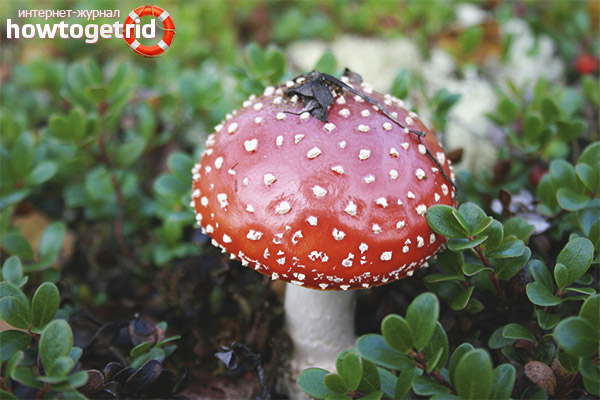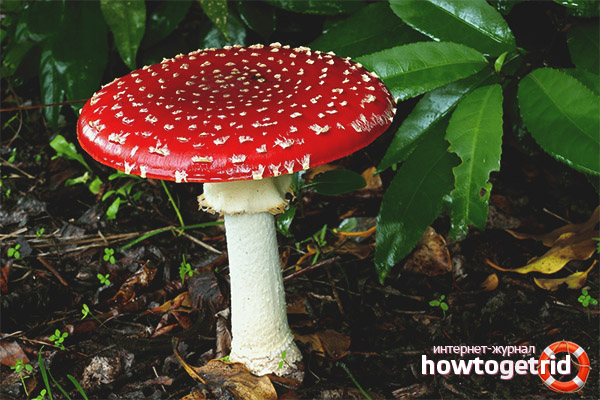The content of the article
- 1 Description of the species, distribution
- 2 Mushroom harvesting features
- 3 Chemical properties and composition
- 4 Pharmacological features and properties
- 5 Application features
- 6 What to consider when using mushrooms
- 7 Interesting facts about the fly agaric, historical background
- 8 Video: how to make a tincture of mushroom
The red fly agaric is a mushroom with a hat of a characteristic red color, decorated with white specks, known to almost every man in the street. This mushroom is considered to be poisonous (medium level) and has a considerable amount of useful properties, so it is widely used as a medicine used in medicine and cosmetology. It belongs to the red mushroom to the family Amanitaceae.
Description of the species, distribution
The red fly agaric is a rather poisonous mushroom belonging to the lamellar species, it has a rather powerful and long leg. Note that, as a rule, at the beginning of its development, the leg of the fungus and its fruit body are enclosed in a common cover.
The red cap of the fly agaric is characterized by high fleshiness, reaching 200 mm in diameter. In the case of just emerging mushrooms, this part has a spherical shape, with growth it becomes flat-convex. The skin of the cap varies from bright orange to red (it becomes lighter with age). The edge of the mushroom cap can be either ribbed or completely smooth. Most of the surface of the cap is dotted with specks (growths of white or yellowish tint). As a rule, young fungi rarely have data characteristic of this species, white outgrowths; in old plants, specks are often washed away during precipitation.
The lamellar tissue of the mushroom varies from light yellow to deep yellow, and, besides, another feature of the plant is that the older it is, the more saturated the color of the plates. The flesh is soft, almost no smell. Spores of the amanita regular shape (ellipse, cylinder), white.
The white stem of the fungus also has the correct shape of a cylinder, a length of up to 200 mm, a diameter of up to 35 mm, the base is tuber-like, covered with rows of white growths, and has a characteristic light ring.
Most often, this type of mushroom is found in mixed forests with a temperate climate. It grows both singly and in groups, the season is summer, autumn.
Mushroom harvesting features
To prepare the powder from mushrooms, the caps are pre-dried, and then thoroughly crushed. It is best to store dried fly agaric in tightly closed, dark glass containers.
Chemical properties and composition
Although the chemical composition of the poisonous fungus has been little studied today, it has nevertheless been found that it contains many alkaloids that are dangerous to the human body, the fungal tropintoxin, choline, betanin, enzymes, muscimol and the pigment muscarufin, which is actually responsible for brightly the red color of the cap of the fungus, as well as other components.
Pharmacological features and properties
The fungus has rather pronounced hallucinogenic properties, which is caused by the presence in its composition of some toxic constituents (ibotenic acid, muscimol, and an alkaloid such as muscarin). Note that the effect of muscarine on the human body is characterized by such symptoms as: constriction of the pupils, a sharp decrease in blood pressure, respiratory depression, a general deterioration of the condition. Mortally dangerous for any person is the amount of such a component as muscarin, contained in 3 kilograms of poisonous fungi of this species.
Atropine is used as an antidote for muscarinic poisoning, the main task of which is to normalize the functioning of the heart.
Application features
The red fly agaric has long been used in folk medicine, its unique properties help to cope with many diseases. Healers prepare various medicinal tinctures and ointments from natural raw materials. One of the main properties of the red mushroom is effective stimulation of the immune system.Also, fly agarics are often used to effectively combat helminths.
The most popular in folk medicine is a tincture prepared using fungi dangerous for humans, mainly intended for the treatment of rheumatic pains and various abscesses, the inflammatory process of the sciatic nerve, help with osteochondrosis, rheumatoid arthritis, and radiculitis.
Also poisonous amanita is also used to treat ailments of the nervous system and paralysis. The positive properties of the fungus are well known in the fight against oncological diseases. It is believed that this gift of Mother Nature will help to cope with cancer, especially at an early stage of development. Due to the effective reduction of both the tumor itself and the removal of painful sensations characteristic of oncological diseases.
What to consider when using mushrooms
I would like to note that poisoning by this type of poisonous mushrooms in its pure form is found, as a rule, very rarely. At the same time, mainly small mushroom pickers, left without parental care while they are in the forest, suffer from this.
Frequently, the fly agarics also occur during various manipulations with natural raw materials using various methods and recipes offered by traditional medicine at home. Often this is due to the use of external alcohol tincture for the treatment of affected limb joints.
Due to the rapid absorption of alcohol tinctures into the skin, a person already after a rather short period of time feels euphoric mood. This is due to the defeat of the parasympathetic system, as a result of which the patient may feel better by reducing pain symptoms. The most dangerous thing in this case is the loss of precious time that could be spent on the real treatment of the disease through the methods of traditional medicine.
Interesting facts about the fly agaric, historical background
- Some data from researchers of shaman scholars indicate that the mention of a red-toed mushroom came to us from ancient Indian mythology. It is from this mushroom that such a famous soma drink was prepared - soma.
- The ancient aborigines of northern Europe learned about the narcotic effect of the red amanita on a living organism when they watched the animals eating these mushrooms.As a result of taking these poisonous mushrooms, a person can experience changes in his consciousness, hallucinations (both hearing and vision are affected). Due to a fairly powerful poisoning, a person usually falls into a heavy narcotic sleep.
- Before the important battles, the ancient Vikings used a few pieces of red toadstools, which caused the soldiers to become clouded, their fear was dulled, and the pain from their wounds was almost not felt, they selflessly fought and defeated their enemies in spite of everything.
- In many manuscripts of the past centuries, cultures practically extinct from the face of the earth are described, using these poisonous mushrooms to perform their rituals (Indians, Kamchadals, Sami, Koryaks, and many others). As a rule, ceremonies were associated with this, allowing one to enter the other world to communicate with their dead relatives.
- Along with the narcotic effect of the mushroom on the body, many also noted their medicinal properties as a result of observing the animals that ate these mushrooms in small quantities to treat their ailments.Note that even Paracelsus used in his medical practice it is a rather poisonous mushroom for the prevention of such illnesses as diabetes and tuberculosis.
- It is known that many toxic alkaloids, due to thorough heat treatment, lose their properties affecting the human body, which is why they are used in food in some countries of Asia, Europe and North America.
- As many know, Amanita is the Latin name for the mushroom, which he received at the expense of his spread. Mount Amanon was previously famous for its large abundance of diverse vegetation, including fungi.
- The Russian name of a poisonous fungus is closely related to its unique insecticidal characteristics: it copes well with the destruction of such annoying insects as flies. For this, a special sweet syrup was made with the addition of pieces of fungus, which effectively acts on insects (the latter quickly die from such a poison).
Also widely known are the positive properties of these fungi in a field such as cosmetology. Specially made extracts practically do not contain harmful toxic components, but have a very valuable complex of antioxidants and enzymes, characterized by high bio-activity.The use of such tools helps to improve the elasticity of the skin, even out the tone and its surface. In addition, it is an excellent natural stimulator of natural processes responsible for cell regeneration and renewal.
Video: how to make a tincture of mushroom













To send